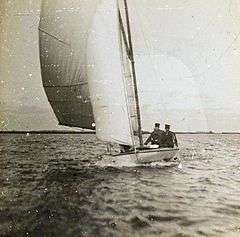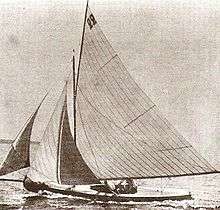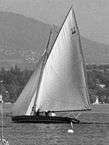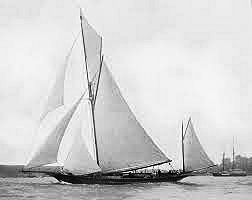Sailing at the 1900 Summer Olympics
Sailing/Yachting made its first appearance as an Olympic sport at the 1900 Summer Olympics after competitions were cancelled at the 1896 Olympics. With the exception of 1904, sailing was thereafter always a part of the Olympic program. The sailing program in 1900 consisted of a total of eight sailing classes. For six classes, the races were scheduled from 20 – 27 May at the river Seine around Meulan, and a series of three races was held for the largest classes from 1–5 August on the North Atlantic off the coast of Le Havre. Approximately 150 sailors in 64 boats (the numbers of boats and competitors are not reliable, as in the official report some figures of the World exhibition and the Olympic Games are mixed) from 6 nations competed, including 1 woman, Hélène de Pourtalès, who won a gold medal in the 1 to 2 ton.[1]
| Sailing at the Games of the II Olympiad | |
|---|---|
| Venues | Meulan Le Havre |
| Dates | 20 May 1900 – 27 May 1900 (Meulan) 1 August 1900 – 5 August 1900 (Le Havre) |
| Competitors | about 150 (including 1 woman) from 6 nations |
| Boats | 64 |
Venues
During the early years of the Olympic movement there were no strict rules for the assignment of venues. For the Olympic sailing in 1900 the organizers decided to combine the Olympic sailing for the smaller yachts with the regattas of the Exposition Universelle on the river Seine near Meulan. For the larger yachts an Olympic regatta was held at Le Havre.
Meulan
During the Olympic regattas of the Exposition Universelle of 1900 there were more than 100 yachts racing from Paris, Rouen, Cannes, Nantes and Arcachon and yachts from England, Germany, the United States and Holland. The Bassin Olympique was the river Seine near the Cercle de la Voile de Paris that served as the Olympic harbor.
The race conditions at Meulan during the Olympic regatta were not ideal. A light breeze could hardly make the sailing interesting. Since the river Seine mainly runs from east to west, the light north-easterly breeze was partly blocked by buildings or trees on the river bank, thus heavily influencing the regatta.
| Cercle de la Voile de Paris Bassin Olympique de Meulan Les Mureaux | |
|---|---|

| |
| General information | |
| Status | Complete |
| Type | Club House |
| Address | 30, quai Albert Glandaz |
| Town or city | 78130 Les Mureaux |
| Country | |
| Coordinates | 49°00′1″N 1°54′54″E |
| Elevation | Sealevel |
| Owner | Cercle de la Voile de Paris |
Le Havre
During the second part of the Olympic regatta the Atlantic Ocean was used for the races of the 10 – 20 ton and the 20+ ton yachts. The conditions during the regatta were so good that the 10 – 20 Ton class was able to sail the complete 22 nautical mile triangular course. The premises of the Société des Régates du Havre were used as Olympic harbor.
| La Société des Régates du Havre Le Havre | |
|---|---|
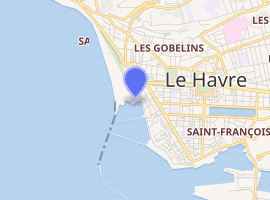
| |
| General information | |
| Status | Destroyed |
| Type | Club House |
| Country | |
| Coordinates | 49°29′30″N 0°5′45″E |
| Elevation | Sealevel |
| Owner | La Société des Régates du Havre |
Course areas
Since there were two venues there were two course areas. One the river Seine near Meulan. Here the organization could set courses of 8, 15 and 19 kilometres (4.3, 8.1 and 10.3 nmi). The other course area was on the North Atlantic off the coats of Le Havre. Here courses could be set up to 40 nautical miles (74 km).

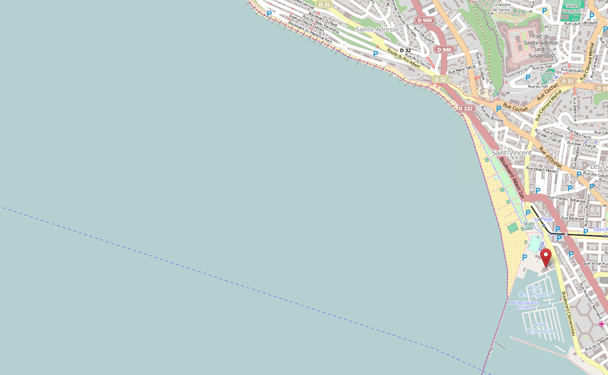
Participating nations
6 nations sent sailors. Several teams had crews from multiple countries, and in one case, they won a gold medal. This team, of the United Kingdom and France, is attributed as a mixed team.
 Map of Participating Sailing Countries at the 1900 Summer Olympics ● Green = Participating for the first time |
|
Classes (equipment)
Sailing during the turn of the century was not as well defined as it became later during the 20th century. Racing rules were mostly defined by local yacht clubs or in some cases by a National Yachting Federation. Also, boats were not standardized to what are now called One Design or One Builder classes. Therefore, many handicap systems or systems that put yachts into different categories were used. In 1892, Auguste Godinet developed a formula that placed different boats in different Ton categories. This rule was adopted by the Union des yachts français and later by several other National Yachting Federations such as the Société Nautique de Genève. For the sailing at the 1900 Olympics this rule was chosen to determine the tonnage of a yacht.
For the smallest class, 0 – ½ Ton, among others, Larks were used. These Larks, copies of the Davis Lark and of the Sorceress designed by Linton Hope, became famous One Designs in France (Monotype de Chatou at the beginning of the 20th century.
The Olympics were open for the following classes:
|
| ||||||
| Class | Type | Venue | Event | Sailors | First OG | Olympics so far |
|---|---|---|---|---|---|---|
| 0 – ½ Ton | Undefined | Meulan | Unknown | 1900 | 1 | |
| ½ – 1 Ton | Undefined | Meulan | Unknown | 1900 | 1 | |
| 1 – 2 Ton | Undefined | Meulan | Unknown | 1900 | 1 | |
| 2 – 3 Ton | Undefined | Meulan | Unknown | 1900 | 1 | |
| 3 – 10 Ton | Undefined | Meulan | Unknown | 1900 | 1 | |
| Open Class | Undefined | Meulan | Unknown | 1900 | 1 | |
| 10 – 20 Ton | Undefined | Le Havre | Unknown | 1900 | 1 | |
| 20+ Ton | Undefined | Le Havre | Unknown | 1900 | 1 | |
| Legend: | ||||||
|
Inshore classes (Meulan)
Offshore classes (Le Havre)
| ||||||
Race schedule
| ● | Meulan competition | ● | Le Havre competition |
| 1900 | May | August | ||||||||||||
|---|---|---|---|---|---|---|---|---|---|---|---|---|---|---|
| 20 Sun | 21 Mon | 22 Tue | 23 Wed | 24 Thu | 25 Fri | 26 Sat | 27 Thu | 1 Fri | 2 Sat | 3 Sun | 4 Mon | 5 Tue | 6 Wed | |
| Sailing | 1 | 1 1 1 | 1 1 1 | 1 1 1 1 | No wind |
1 | 1 | 1 | 1 | |||||
| Total gold medals | 1 | 3 | 3 | 4 | 1 | 1 | ||||||||
Medal summary
The results of the individual races are known; however, in the past there has not been consensus on which races were considered "Olympic" and thus who the Olympic medalists were. The Official Report,[2] International Olympic Committee (IOC),[3] International Sailing Federation (ISAF)[4] and Sports Reference[5] present different medalists. The IOC has never decided which events were "Olympic" and which were not.[6] Occasionally, sources differ on the nationality of competitors (such as H. MacHenry, alternately listed as French or American). For example, the medalists in the 3 – 10 Ton races are shown in the various sources as:
| Report | Race | Gold | Silver | Bronze |
| Official Report[2] | Race 1 | Henri Gilardoni (FRA) | Henri Smulders (NED) | Maurice Gufflet (FRA) |
| Race 2 | Howard Taylor (GBR) | Maurice Gufflet (FRA) | H. MacHenry (FRA) | |
| IOC[3] and ISAF[4] | Race 2 | Howard Taylor (GBR) | Maurice Gufflet (FRA) | H. MacHenry (FRA) |
| Sports Reference[5] | Race 1 | Henri Gilardoni (FRA) | Henri Smulders (NED) | Maurice Gufflet (FRA) |
| Race 2 | Howard Taylor (GBR) | Maurice Gufflet (FRA) | H. MacHenry (USA) |
In all classes at Meulan except the Open class, there were two distinct "finals." Boats were assigned time handicaps according to their weight within each class and prizes were handed out to the winners of each race. The IOC initially recognized the winner of the first race in each class as Olympic champion except in the case of the 10 – 20 ton class, which was decided on aggregate time over three races. However, currently the participants of both first and second races in three classes (0 – 0.5t, 1 – 2t and 2 – 3t) are present in the IOC database[7] as medalists. That is, the second race in each of these three classes is recognized by the IOC and for each of these events two gold, two silver, and two bronze medals were retrospectively awarded by the IOC. In the 3 – 10 Ton race, however, only the second race winners are listed with Olympic medals.
The data below notes all races and medalists of the regattas of the Games of the second Olympiad, as well as of the Exposition Universelle and counts all winners as medalists, because the IOC website currently affirms a total of 95 medal events in the Games.[8]
- The second race in this class is also recognized by the IOC. Thus, for this event, two gold, two silver, and two bronze medals were retrospectively awarded.
- This race in this class is not shown in the IOC database as an Olympic medal event. However, the IOC website currently has affirmed a total of 95 medal events, after accepting, as it appears, the recommendation of Olympic historian Bill Mallon for events that should be considered "Olympic". These additional events include these other two previously uncounted sailing races.[8][9]
Medal table
|
All races now considered official Olympic events, as IOC website affirms 95 total medal events.
NotesThere was some discussion about the validity of the Olympic status of Sailing at the 1900 Summer Olympics. The following quote states the status quo on this subject:
Other informationDuring the sailing regattas at the 1900 Summer Olympics among others the following persons were competing (or owning yachts) in the various classes:
Further reading
References
"Paris 1900". Olympic.org. International Olympic Committee. | |||||||||||||||||||||||||||||||||||||||||||||||||||||


